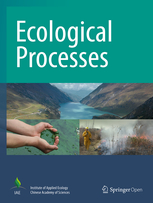Ver ítem
- xmlui.general.dspace_homeCentros Regionales y EEAsCentro Regional Patagonia SurEEA Santa CruzArtículos científicosxmlui.ArtifactBrowser.ItemViewer.trail
- Inicio
- Centros Regionales y EEAs
- Centro Regional Patagonia Sur
- EEA Santa Cruz
- Artículos científicos
- Ver ítem
Modeling of potential habitat suitability of Hippocamelus bisulcus: effectiveness of a protected areas network in Southern Patagonia
Resumen
Introduction
Huemul (Hippocamelus bisulcus Molina) is the most threatened flag species of Southern Patagonia, where conservation efforts were not effective to avoid the retraction of its distribution area. Habitat quality modeling can assist to design better management strategies for regional conservation planning. The objective was to elaborate one habitat suitability map for huemul, defining the environmental characteristics at landscape level, and
[ver mas...]
Introduction
Huemul (Hippocamelus bisulcus Molina) is the most threatened flag species of Southern Patagonia, where conservation efforts were not effective to avoid the retraction of its distribution area. Habitat quality modeling can assist to design better management strategies for regional conservation planning. The objective was to elaborate one habitat suitability map for huemul, defining the environmental characteristics at landscape level, and determining the distribution of the suitable habitat inside the current natural reserve network.
Methods
We used a database of 453 records and explored 40 potential explanatory variables (climate, topographic, and landscape variables including human-related ones) to develop one habitat suitability map using the Environmental Niche Factor Analysis (ENFA) for Santa Cruz province (Argentina). We combined the outputs in a GIS project using different shapes, including the current natural reserve network.
Results
We defined the potential habitat for huemul, where forest edges and ecotone zones (e.g., mainly alpine environments) were the most important environmental variables, as well as some forest types (e.g., Nothofagus pumilio). Habitat losses were found in the extreme potential distribution areas (northern and southern areas), probably related to the increasing ranch activities. The current natural reserve network maintains approximately half of the huemul potential habitat in Santa Cruz province, where National Parks presented the similar conservation importance than the Provincial natural reserves.
Conclusions
Habitat suitability model for huemul can be used as a decision support system for new management strategies at different landscape levels to improve the current conservation efforts.
[Cerrar]

Autor
Rosas, Yamina Micaela;
Peri, Pablo Luis;
Huertas Herrera, Alejandro;
Pastore, Hernán;
Martínez Pastur, Guillermo José;
Fuente
Ecological processes 6 (28). (2017)
Fecha
2017
Editorial
Springer
ISSN
2192-1709
Formato
pdf
Tipo de documento
artículo
Palabras Claves
Derechos de acceso
Abierto
 Excepto donde se diga explicitamente, este item se publica bajo la siguiente descripción: Creative Commons Attribution-NonCommercial-ShareAlike 2.5 Unported (CC BY-NC-SA 2.5)
Excepto donde se diga explicitamente, este item se publica bajo la siguiente descripción: Creative Commons Attribution-NonCommercial-ShareAlike 2.5 Unported (CC BY-NC-SA 2.5)


